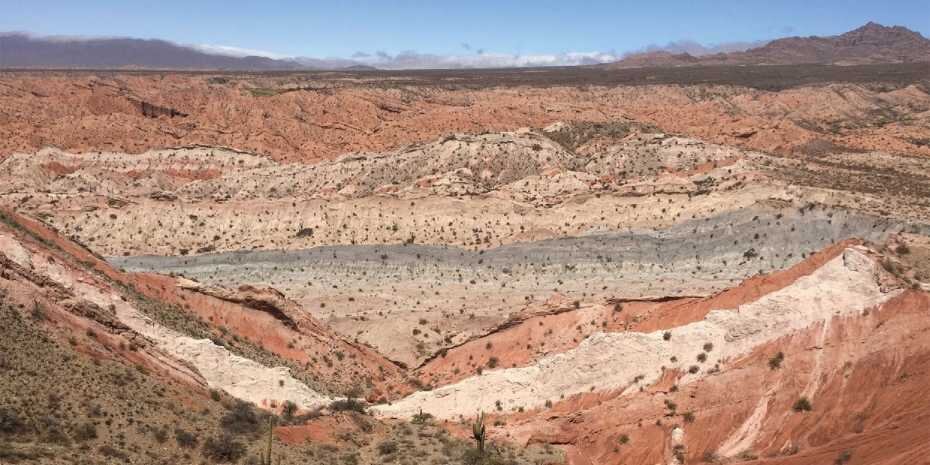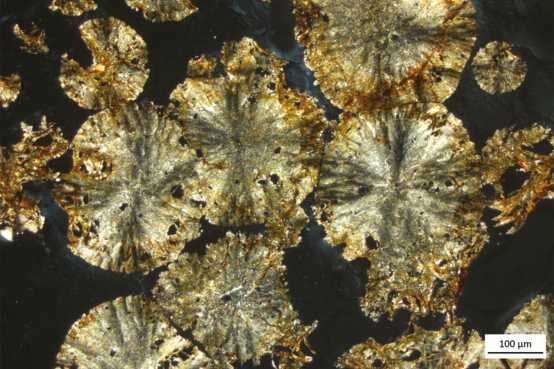
[ad_1]

Very promising siderite deposit in Argentina. Credit: Joep van Dijk / ETH Zurich / by van Dijk J, et al, Nat. Geosc., 2020
Hot and humid: Using minerals from ancient soils, ETH researchers are reconstructing the climate that prevailed on Earth some 55 million years ago. Their findings will help them better assess what our climate might look like in the future.
Between 57 and 55 million years ago, the geological epoch known as the Paleocene ended and gave way to the Eocene. At that time, the atmosphere was essentially flooded with carbon dioxide from greenhouse gases, with concentration levels ranging from 1,400 ppm to 4,000 ppm. So it’s not hard to imagine that temperatures on Earth must have resembled those in a sauna. It was hot and humid and the ice on the polar caps had completely disappeared.
The climate of that era provides researchers with an indication of how today’s climate could develop. While the pre-industrial levels of atmospheric CO2 stands at 280 ppm, today’s measurement of 412 ppm. Climate scientists believe that CO2 emissions generated by human activity could bring this figure up to 1,000 ppm by the end of the century.
Using tiny siderite minerals in soil samples taken from former marshes, a group of researchers from ETH Zurich, Pennsylvania State University and CASP Cambridge (UK) reconstructed the climate that prevailed in the late Paleocene and beginning of the Eocene. Their study has just been published in the journal Nature Geoscience.
Siderite minerals formed in an oxygen-free soil environment that developed under dense vegetation in swamps, which were abundant along the warm, humid coasts in the Paleocene and Eocene.
To reconstruct climatic conditions from the equator to the polar regions, the researchers studied siderites from 13 different sites. These were all located in the Northern Hemisphere, covering all geographic latitudes from the tropics to the Arctic.
Prevailing humidity
“Our reconstruction of the climate based on siderite samples shows that a warm atmosphere is also accompanied by high levels of humidity,” says lead author Joep van Dijk, who completed his doctorate in Professor Stefano Bernasconi’s group at the ‘ETH Institute of Geology from 2015 to 2018.
As a result, between 57 and 55 million years ago, the average annual air temperature at the equator where Colombia is today was around 41 ° C. In Arctic Siberia, the average summer temperature was 23 ° C.

Thin section of siderite crystals from Alaska under the microscope. Credit: Washington State Univ / Seattle
Using their siderite “hygrometer,” the researchers also showed that the global moisture content in the atmosphere, or specific moisture, was much higher in the Paleocene and Eocene than it is today. In addition, water vapor remained in the air longer because specific humidity increased at a faster rate of evaporation and precipitation. However, the increase in specific humidity was not the same everywhere.
Since they had access to siderite from all latitudes, the researchers were also able to study the spatial model of specific humidity. They found that the tropics and higher latitudes would have very high humidity levels.
Researchers attribute this phenomenon to water vapor transported to these areas from the subtropics. Specific humidity increased less in the subtropics. As evaporation increased, rainfall decreased. This resulted in a higher level of atmospheric water vapor, which eventually reached the poles and the equator. And the atmospheric vapor carried the heat with it.
Climate scientists still observe the flow of water vapor and heat from the subtropics to the tropics today. “It is likely that latent heat transport was even greater during the Eocene,” says van Dijk. “And the increased heat transport to high latitudes may have favored intensification of warming in the polar regions,” he adds.
Not enough time to adapt
These new findings suggest that today’s global warming goes hand in hand with an increase in the transport of moisture and, by extension, heat in the atmosphere. “The transport of atmospheric moisture is a key process that enhances the warming of the polar regions,” explains van Dijk.
“Although the CO2 the content in the atmosphere was then much higher than it is today, the increase in these values has occurred over millions of years “, he points out.” Things are different today. Since the beginning of industrialization, humans have more than doubled the level of atmospheric CO22 over a period of only 200 years, “he explains. In the past, animals and plants had much more time to adapt to changing climatic conditions.” They just can’t keep up with today’s rapid development, ”says van Dijk.
Tiring search for siderite crystals
Finding the siderites wasn’t easy. For one thing, the minerals are tiny, plus they are found exclusively in fossil swamps, which today are often found a few kilometers below the earth’s surface. This made it difficult or even impossible for researchers to dig the siderites themselves. “We have made several expeditions to sites where we believed sideritis might occur, but we only found them in one of these locations,” says van Dijk.
Fortunately, one of the study’s co-authors, Tim White, an American from Pennsylvania State University, owns the world’s largest collection of siderite.
Throw a warm sheet on our understanding of ice and climate
Joep van Dijk et al. Spatial scheme of super-greenhouse heat controlled by high specific humidity, Nature Geoscience (2020). DOI: 10.1038 / s41561-020-00648-2
Quote: Ancient Soil Minerals Reveal Earth’s Climate History (2020, Oct 27) Recovered Oct 28, 2020 from https://phys.org/news/2020-10-ancient-soil-minerals-reveal-earth. html
This document is subject to copyright. Aside from any conduct that is correct for private study or research purposes, no part may be reproduced without written permission. The content is provided for informational purposes only.
[ad_2]
Source link